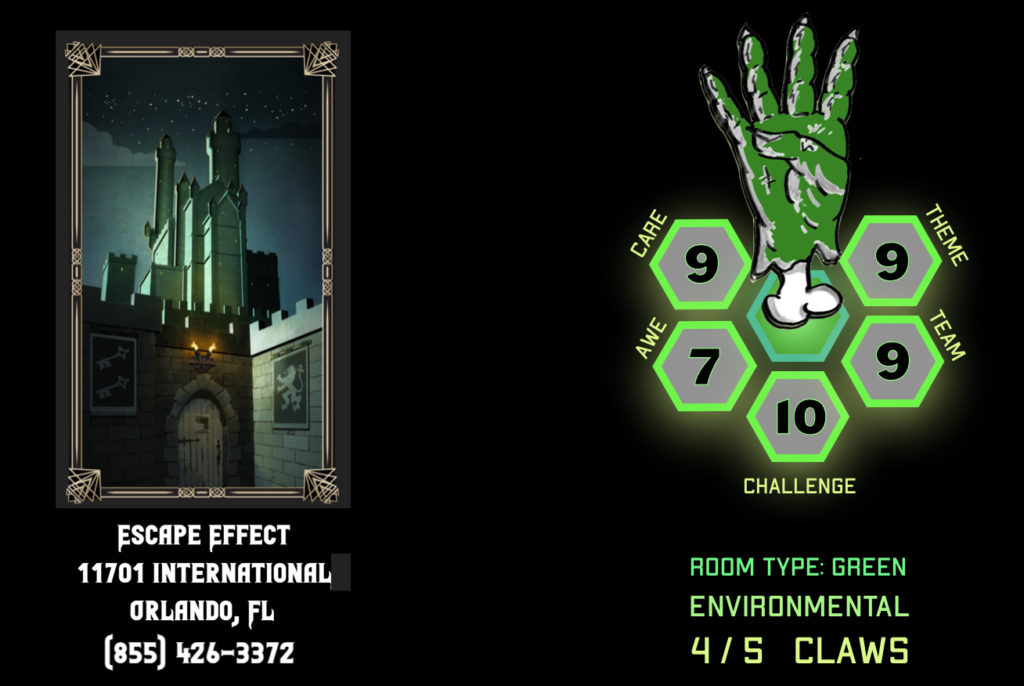
How much do we really want to listen to our teammates?
I really enjoyed myself at A Knight to Escape, not once, but twice!
We were excited to join a special preview of The Escape Effect’s latest room as part of their appearance on Good Morning Orlando; being fans of their other rooms, I eagerly agreed to the early start time. We began at 7am and as anyone who knows me can attest, that is not my finest hour of the day. While that made it difficult for me to focus, I was rewarded with two of my favorite elements of escape rooms: medieval themes, and teamwork-based challenges. Even if I had been at my sharpest, this is a 2-hour room, and for good reason; you will need all 120 minutes.
The room breaks teams into two groups (the venue’s website describes them as “one light and one dark”), one group is trapped in the castle’s dungeon trying to get out and the other group begins in the castle courtyard trying to break in; puzzles largely focus on how well each half communicates with the other. Since Michael wasn’t able to join us for my first playthrough, I thought it would be fun to go along a second time and see the room from the courtyard side, having started in the dungeon earlier.
The medieval setting created by The Escape Effect is the best of its genre in Orlando, hands down, and features a magnificent set. In fact, it’s two magnificent sets. The result is a deeply immersive experience regardless of which group you’re a part of. Each half presents a very different experience, though, so you want to make an informed choice about which side you go on. The dungeon is not utterly dark, and kids in your group will probably love the way its passages seem to run through a number of different chambers. The courtyard side is bright and filled with tiny details that would appeal to observant players good at remembering things.
Since this room contains so many puzzles for the 2-hour playtime, I was slightly surprised that the game doesn’t really provide as much of a replayable experience as I had hoped; even with the two distinct paths through the room, after you’ve played it once, you know too much. That’s not a complaint though; replayability is kind of the Holy Grail of escape room design, so that would have been asking a lot (and it wasn’t what the owners were really going for.) I don’t think the room can really be replayed since the puzzles involve team-members’ working from either side of the experience, but they are both immersive in different ways. You will want to make sure the people with the best eyesight go to the dungeon side.
As always with this venue, the puzzles were ingenious, and they look amazing; on top of that, a couple of them are masterpieces of construction and deductive reasoning. My only criticism is, I wish the puzzles were a bit more asynchronous. I like how the theme of cooperation seeps into every puzzle and requires constant communication across the castle/dungeon divide, but at times it did add a little extra pressure for our groups; since nearly every puzzle requires someone from each side to work on it at the same time, when the team as a whole isn’t making progress the lagging side starts to feel like they just aren’t ‘getting it’, which can be frustrating for someone struggling in the darkness, while the other side starts to feel powerless to help their teammates. During each of my playthroughs I never really felt confident in my surroundings because the more I looked around or struggled with a puzzle, the more someone else was waiting on me to get them the information or piece they needed. Reuniting with my team and everyone finally getting access to each side was the only thing that really alleviated that situation and I would have loved to have the two groups merge a little sooner, so that each team member can gravitate toward the challenges they enjoy/excel at rather than struggling with the ones on their own sides.
Unfortunately, my enthusiasm for the room resulted in communication problems with my teammates right from the beginning; I really should have listened to Michael when he said he wasn’t feeling well enough for an escape room. He hadn’t slept, wasn’t over his cold, and forgot his glasses but, knowing how fantastic The Escape Effect’s other rooms are, he chugged some NyQuil and valiantly gave it his best. [EDITOR: due to the mitigating factors of Michael’s illness and Paul’s having seen each side of the experience, Michael is abstaining from scoring this room in Partly Wicked’s usual format, instead, offering his own unique, free-form thoughts below.]
Overall, there’s a core gameplay concept throughout the room that guides the entire experience; it demands clear communication between team members particularly when no single person can see all that they need to at a single time. Be ready to embrace that element so you can fully enjoy and appreciate A Knight to Escape for the ‘must-see’ experience it is.
Michael:

NOTE: I was not in top form when I played this game, which started at Silly O’Clock. I was exhausted. I had an awesome time, but if you’re reading my half of this article, bear in mind, this is my reaction, it’s not a well-informed review, because I am not a morning person.
The castle’s ingenious layout suggests many passages and bowers. As I sat writing sonnets in the library, my teammates banged and clattered and shouted curses at me through the walls. “Why are you so useless?” someone yelled, and “I thought you’d leap into action once you were here?” while Paul wanted to know if I was trying to ruin his whole life or just that one day. The wonderful decor made it easy to ignore them, and I had a splendid time strolling through the mesmerizing set. But even when I was paying attention to the game, I couldn’t tell what kind of story I was in. It’s never quite an Errol Flynn-era swashbuckler, or a story of King Arthur… it never settles into PBS “historical fiction”, but it never intensifies into “sword & sorcery” either. It’s like a studio set in search of a script, or a pitch meeting trying to get off the ground.
Often, two players must each find one-half of a puzzle they’re meant to do together. Ideally, each of those halves would seem like a metaphor for the other, or at least like they belong together. These sometimes have superficial links, but they don’t run deep enough. Dan Suleski, a masterful game designer, has not yet found the dramatic context for this room’s most innovative quality: the two halves, and their relationship to each other. I think this owes as much to an unfinished premise as anything.
I do think working on the story is key, and it might just need a little nudge. What if the royal family always suspected they might one day be overthrown, and so they designed their castle’s dungeon with a hidden escape room leading out of it, in case they were ever thrown in there to rot? Maybe they were the ones who made it possible to eavesdrop on the castle from the dungeon. If the escape route was put there by the royal family (but hidden so that it could still function as a jail) it would make sense that the players snooping around the castle could find clues about the secrets in the prison. If anything, it would make puzzle-components in one half rhyme more aptly with their counterpart in the other half.
It’s literally dark in the dungeon half, so looking around doesn’t help, and when the game starts, your light source has been sabotaged by an unwelcome puzzle in exactly the wrong place. But the game gets progressively better until a nice looking centerpiece brings everyone together again. I think the endgame could be less cerebral, since it comes after two hours. I’m not a fan of onerous finales; ERs should end with flashy, relatively easy puzzles, that involve everyone at once.
Like all Suleski’s games, this one is driven by a single, perfectly coherent gameplay concept: an innovative two-perspectives-on-one-problem setup. But I wish players were given inspirations to celebrate that concept, rather than cope with it. Despite my quibbles, it’s already a landmark among escape rooms, and it’s a must-see attraction in Orlando. (Especially for enthusiasts.)
Read more posts in the category:
Review
More posts from:
October 2019 / All of 2019
